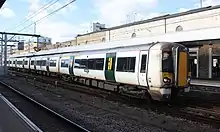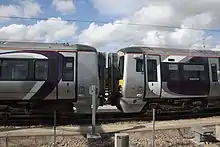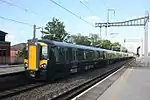British Rail Class 387
The British Rail Class 387 is a type of electric multiple unit passenger train built by Bombardier Transportation, as part of the Electrostar family. A total of 107 units were built, with the first train entering service with Thameslink in December 2014. The trains are currently in service with Great Western Railway, Govia Thameslink Railway, c2c and Heathrow Express. The Class 387 is a variation of the Class 379 Bombardier Electrostar, albeit with dual-voltage capability, meaning the units can also run under 750V third rail, as well as 25kV OLE. The class were the final rolling stock orders based on the Bombardier Electrostar family with 2,805 vehicles built over 18 years between 1999 and 2017.[1]
| British Rail Class 387 Electrostar | |
|---|---|
 A Great Western Railway Class 387 at Acton Main Line in 2017 | |
 The interior of a GWR Class 387 | |
| In service | 8 December 2014 – present |
| Manufacturer | Bombardier Transportation |
| Built at | Derby Litchurch Lane Works |
| Family name | Electrostar |
| Replaced | |
| Number built | 107 units (428 carriages) |
| Formation | 4 carriages per unit |
| Operator(s) | |
| Specifications | |
| Car length | 20.39 metres (66 ft 11 in) |
| Width | 2.80 metres (9 ft 2 in) |
| Height | 3.77 metres (12 ft 4 in) |
| Maximum speed | 110 mph (177 km/h) |
| Traction system | IGBT-VVVF (Bombardier MITRAC DR1000) |
| Power output | 1.68 megawatts (2,250 horsepower) |
| Electric system(s) | 750 V DC Third rail 25 kV 50 Hz AC Overhead |
| Current collection method | Contact shoe Pantograph |
| Safety system(s) | AWS, TPWS ETCS (Heathrow Express fleet only) |
| Track gauge | 1,435 mm (4 ft 8 1⁄2 in) standard gauge |
Description
Class 387/1
The first Class 387/1s were ordered for the Thameslink route, which enabled the existing Class 319s to be transferred to Northern Rail for use on the newly electrified Manchester Victoria to Liverpool via Newton-le-Willows route.[2][3]
On behalf of the Department for Transport, Southern issued an OJEU notice in December 2012[2] with proposals received in January 2013. The invitation to tender for the fleet was released the following month with final offers being submitted by 18 June 2013. Southern announced it had signed a deal with Bombardier on 30 July 2013 for 29 four carriage units.[4][5]
In October 2015, Porterbrook placed a speculative order for 80 carriages. Fifty-six were later leased to Great Western Railway and the remaining 24 to c2c as 387/3s.[6]
The Class 387/1 fleet is subdivided into a Class 387/1a fleet which has been fitted with the ETCS signalling system for use in the Heathrow Airport railway tunnels[7] (and in along the entire route in future). This subfleet was authorised for use in passenger service under ETCS by the ORR on 14 December 2020.[7]
Class 387/2
Govia ordered 27 four-carriage units to replace Class 442s on the Gatwick Express service.[8] The first units entered service in February 2016.[9][10][11]
Class 387/3
In April 2016, c2c announced that it would operate six Class 387s to add capacity on the c2c network.
Current operations
Gatwick Express

As part of Govia's bid for the Thameslink, Southern and Great Northern franchise, 27 four-carriage units were ordered to replace Class 442s on the Gatwick Express service, using some of the optional 140 extra carriages.[8] The order was announced in November 2014 with the first units on test in July 2015 and they began to enter service on 29 February 2016.[9][10][11]
The deployment was disrupted by unionised drivers refusing to take passengers, claiming that the twelve coach Class 387 trains are not covered by their driver only operation agreement which is limited to ten coaches, and that running them without a conductor would be unsafe. In response to this, Govia threatened to take legal action, and the union ultimately dropped the claim. Prior to entering service with Gatwick Express, several units entered service with Thameslink in response to delays with commissioning the Class 700 units. These then returned to Gatwick Express by the end of Summer 2016.[12][13]
Great Western Railway

The first Great Western Railway unit entered service on 5 September 2016 running between London Paddington and Hayes & Harlington in peak hours to relieve congestion on some of the country's most crowded trains.[14][15] In January 2017 GWR began running a half-hourly Paddington to Hayes and Harlington service using pairs of these 387/1s.[14]
On 1 January 2018, following further electrification work, Class 387/1 EMUs began operating suburban services between London Paddington and Didcot Parkway, replacing GWR Class 165 DMUs on these services.[16] Due to electrification being suspended from Didcot Parkway to Oxford, the previous Oxford suburban service from London Paddington was cut back to Didcot Parkway to allow electric trains to operate this service. Oxford is still served by the fast services from London Paddington and a DMU service from Didcot Parkway.[17]
In January 2019, Class 387/1 EMUs began operating between Reading and Newbury after electrification works on the Reading to Taunton line had been finished. In December 2019, Class 345s took over most of the GWR stopping services between Reading and Paddington. This displaced 12 Class 387s are now used on Heathrow Express services between Heathrow Terminal 5 and Paddington. GWR proposes to use Class 387s on special services to Cardiff when events are held at the Millennium Stadium.[18]
c2c
The first c2c Class 387 was delivered in October 2016 and entered service in November 2016.[19] These trains were built primarily as stock units; they were leased out to c2c which at the time was suffering with overcrowding.[20][21]
Great Northern

From late 2016, 29 of the Class 387/1s operating on Thameslink were displaced by the delivery of Class 700s, and were transferred to Great Northern. They operate mostly on the Kings Cross–Cambridge–King's Lynn route, though they can also be seen on other services. These units were delivered in a white livery, with Southern green doors and Southern moquette.
In 2018, 387105 was transferred to Gatwick Express on a permanent basis, but was not relivered into Gatwick Express red.[22] It was transferred back to Great Northern in May 2020.[23]
Heathrow Express

In March 2018, Heathrow Airport Holdings came to an agreement with Great Western Railway (GWR) to take over the operation of the Heathrow Express service between London Paddington and Heathrow Airport from August 2018.[24] In September 2019, Heathrow Express confirmed that operation of the service would pass to GWR with ownership remaining with Heathrow Airport Holdings until at least 2028. GWR would provide and maintain the Class 387 units for the service from 2020, with the Class 332 trains withdrawn from service.[25]
Twelve Class 387 units from the GWR fleet were modified to provide a dedicated set of trains for the service including first class accommodation, high speed Wi-Fi, additional luggage racks and on-board entertainment.[26][27] The Heathrow Express sub-fleet has been designated as Class 387/1a due to their unique fitment of the ETCS signalling system for use in the Heathrow Airport railway tunnels.[7]
The first units entered revenue earning service with Heathrow Express on 29 December 2020.[28]
Former operations
Thameslink

The first Thameslink unit entered service in December 2014 with all in service by July 2015.[29] They were operated by Thameslink on services between Bedford and Brighton.
During Summer 2016, several of Gatwick Express Class 387/2 units entered service with Thameslink prior to introduction on Gatwick Express services due to the delay of the Class 700 units, although these returned to service with Gatwick Express after a few months.
The Class 387/1s have since been transferred to Great Northern working services from Kings Cross to Peterborough and Cambridge/King's Lynn.
Accidents
- 387117 collided with the buffer stops on platform 9 at London King's Cross station, on 15 August 2017.[30][31]
- 387146 derailed near West Ealing railway station, on 27 November 2018.[32]
Fleet details
| Class | Operator | Number built | Year built | Cars per unit | Unit numbers |
|---|---|---|---|---|---|
| 387/1 | Great Northern | 29 | 2014–15 | 4 | 387101–387129 |
| Great Western Railway | 33 | 2016–17 | 4 | 387142-387174 | |
| 387/1a[7] | Heathrow Express | 12 | 2016-17 | 4 | 387130-387141 |
| 387/2 | Gatwick Express | 27 | 2015-16 | 4 | 387201–387227 |
| 387/3 | c2c | 6 | 2016 | 4 | 387301–387306 |
One unit so far has been named:
- 387124 - "Paul McCann"[33]
Liveries
 Thameslink liveried 387113 at Bedford
Thameslink liveried 387113 at Bedford Great Northern liveried 387121 at Ely
Great Northern liveried 387121 at Ely Gatwick Express liveried 387204 at Gatwick Airport
Gatwick Express liveried 387204 at Gatwick Airport GWR liveried 387148 at Maidenhead
GWR liveried 387148 at Maidenhead_in_Heathrow_livery.JPG.webp) Heathrow Express liveried coach from 387140 at Reading TCD
Heathrow Express liveried coach from 387140 at Reading TCD
Interiors
 The interior of First Class aboard a Great Northern Class 387/1
The interior of First Class aboard a Great Northern Class 387/1 The interior of Standard Class aboard a Great Northern Class 387/1
The interior of Standard Class aboard a Great Northern Class 387/1 The interior aboard a GWR Class 387
The interior aboard a GWR Class 387 The interior of First Class aboard a Gatwick Express Class 387/2
The interior of First Class aboard a Gatwick Express Class 387/2 The interior of Standard class aboard a Gatwick Express Class 387/2
The interior of Standard class aboard a Gatwick Express Class 387/2
References
- "Last-ever Electrostar finished in Derby as 18 years of production come to an end". www.railtechnologymagazine.com. Retrieved 1 January 2021.
- "Bombardier to manufacture 116 new train carriages for Thameslink rolling stock cascade" (Press release). Southern. 17 July 2013. Retrieved 5 June 2015.
- Thameslink Southern & Great Northern Invitation to Tender Department for Transport 26 September 2013
- Commuters to benefit from state of the art electric trains Department for Transport 30 July 2013
- Bombardier Transportation Wins UK Rolling Stock Contract Archived 3 March 2014 at the Wayback Machine Bombardier Transportation 30 July 2013
- "Porterbrook orders 387s to meet electrification demands" Rail issue 787 11 November 2015 page 13
- Government welcomes new carriages for the Gatwick Express and Thameslink routes Department for Transport
- "Govia and Bombardier sign Gatwick Express train contract". Railway Gazette International. DVV Media Group. 18 November 2014. Retrieved 5 June 2015.
- Gatwick Express Class 387/2 EMU on test Archived 14 October 2015 at the Wayback Machine Railway Gazette International 23 July 2015
- "Late-February debut for Gatwick Express Class 387/2s". Rail. Bauer Consumer Media. 3 February 2016. Retrieved 8 November 2020.
- Lea, Robert (11 April 2016). "Gatwick Express drivers' strike threat over longer trains". The Times. Retrieved 8 November 2020.
- "THE SAFETY-CRITICAL ROLE OF THE GUARD" (PDF). RMT. Archived (PDF) from the original on 26 December 2020. Retrieved 8 November 2020.
- "Introducing our new trains". www.gwr.com. Retrieved 30 September 2016.
- "First Electrostars enter service on Great Western Railway".
- "GWR Electrostar fleet enters service after electrification completed". 2 January 2018. Archived from the original on 17 May 2018. Retrieved 7 January 2018.
- "New GWR trains enter service after electrification". 2 January 2018. Retrieved 7 January 2018.
- Application to the Office of Rail Regulation for a passenger track access agreement, or amendment to a passenger track access agreement under sections 17-22A of the Railways Act 1993 Office of Rail & Road August 2020
- "c2c Class 387s enter service". 22 December 2016.
- "c2c delays: late night crush on trains so bad that 'businessmen wet themselves'". Evening Standard. 29 January 2016. Retrieved 17 March 2018.
- "What complaints did you have about overcrowding before the timetable change, and how does it compare to now?". c2c. Archived from the original on 17 March 2018. Retrieved 17 March 2018.
- 387/1 joins GatEx Rail issue 866 21 November 2018 page 29
- Track Record The Railway Magazine issue 1432 July 2020 page 81
- "GWR to manage Heathrow Express operations". International Railway Journal. 28 March 2018. Retrieved 18 March 2020.
- "Heathrow Express service confirmed to at least 2028". Heathrow Express. Archived from the original on 6 December 2020. Retrieved 18 March 2020.
- 2018-03-28T09:58:56+01:00. "GWR to manage Heathrow Express service". Railway Gazette International. Archived from the original on 3 June 2020. Retrieved 18 March 2020.
- "Heathrow Express | New Fleet". Heathrow Express. Retrieved 16 January 2021.
- "Today's the day we're rolling out our new Heathrow Express fleet!". Heathrow Express.
- "New air-conditioned trains enter service on Thameslink : Thameslink and Great Northern".
- – Rail Accident Investigation Branch Accident Report. Retrieved 16 October 2018
- Hartley-Parkinson, Richard. "Meanwhile, a train at London's King's Cross Station appeared to have hit the buffers on platform nine". Metro. Associated Newspapers. Archived from the original on 15 August 2017. Retrieved 15 August 2017.
- Trim, Liam (27 November 2018). "Photos show derailed train causing 'chaos' at Paddington". getwestlondon. Retrieved 27 November 2018.
- "387124 20170518 Biggleswade KingsCross". Flickr. Archived from the original on 26 December 2020. Retrieved 18 May 2017.
External links
![]() Media related to British Rail Class 387 at Wikimedia Commons
Media related to British Rail Class 387 at Wikimedia Commons